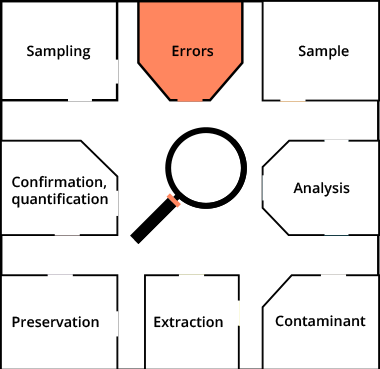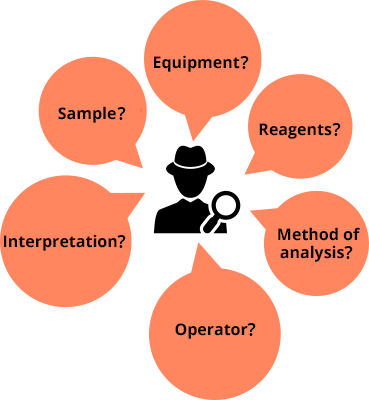Errors
During contaminant analysis, there are many possible sources of error, as shown in the figure below.
Sample?
The heterogeneity of the object of investigation can be an important source of error if the sampling is not done properly, as can the heterogeneity of the sample taken. Performing a pre-treatment step of the sample (e.g. grinding) may help to better homogenize the sample - duplicate or triplicate analyses are advised too.

EQUIPMENT?
The choice of equipment (sample container, glassware, etc.) is also important. It must be compatible with the nature of the contaminant to be analyzed (e.g. avoid a plastic container if you need to analyze plastic migrants). The equipment must be washed, rinsed, and sometimes dried or deactivated, to avoid any loss of the contaminant by adsorption on the materials used or any contamination coming directly from the materials. It may be useful to do some “blank tests” (omitting the sample) with the equipment.
REAGENTS?
The purity of the reagents and solvents is crucial. As the contaminants to be analyzed are at trace levels, any trace of impurity in a reagent or solvent can interfere with the contaminant of interest and falsify the analysis. Furthermore, certain contaminants are likely to be present in trace amounts in certain reagents or solvents (e.g. pesticide residues in some solvents). Therefore, only high purity will guarantee the absence of contamination related to the use of reagents or solvents: this should be checked with an analysis of reagent “blanks” (omitting the sample).
INTERPRETATION?
The processing and interpretation of the analysis data is a step that can also lead to certain errors. Here again, the know-how of the operator or laboratory is important.
OPERATOR?
The operator is often a source of error, and this is all the more true in the case of delicate contaminant analyses.
The operator must have expertise in this kind of analysis. He/she (and, more broadly, the laboratory concerned) has to participate in annual tests to ensure that these skills are maintained over time.
Refer to the metrology sheet
METHOD OF ANALYSIS?
If a method of analysis is not suitable for the sample and/or the contaminant being tested, it can lead to errors. That is why it is important to use a validated method for the analysis under consideration. The analysis of “quality control” samples will ensure that there are no problems in the implementation of the method.
Refer to the metrology sheet


Your investigation
Which source of error do you consider to be the most important in your investigation?
Clue
The heterogeneity of the cargo of coffee is no doubt the main source of error, particularly with regard to ochratoxin A contamination (very local development of the moulds producing this mycotoxin is possible).






